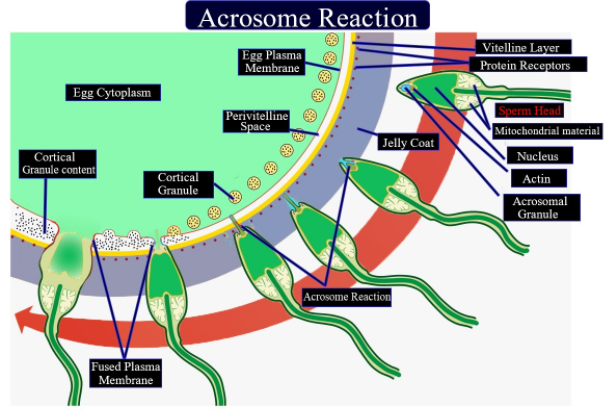
The fertilization cone, which pulls the sperm into the egg, is formed from
(a)Acrosome of the sperm
(b)Acrosomal process of the sperm
(c)Vitelline layer of the egg
(d)Plasma membrane of the egg
Answer
481.5k+ views
Hint: During fertilization, sperm cells undergo a reaction process to penetrate the female egg cell. Glycoproteins on the outer surface of the sperm then bind with glycoproteins on the zona pellucida of the ovum in order to fertilize it.
Complete answer:
The fertilization cone is formed from the plasma membrane of the egg, which draws the sperm into the egg. While fertilization, a sperm should first combine with the plasma membrane of the female ovum, then penetrate to fertilize it. Fusing to the ovum usually causes a little problem, whereas penetrating through the egg's hard shell or extracellular matrix can present more of a problem to the sperm. Therefore, sperm cells go through a process known as the acrosome reaction, in which glycoproteins on the outer surface of the sperm then bind with glycoproteins on the zona pellucida of the ovum in order to fertilize it.
Additional Information: After the sperm goes to the cytoplasm of the oocyte, the tail and the outer coating of the sperm disintegrate and the cortical reaction occurs, preventing other sperm from fertilizing an equivalent egg. The oocyte now goes through its second meiotic division giving rise to the haploid ovum and releasing a polar body. The sperm nucleus then fuses with the ovum, allowing fusion of their genetic material.

So, the correct answer is ‘Plasma membrane of the egg’.
Note: At the start of the process, the sperm undergoes a series of changes, as freshly ejaculated sperm is unable or poorly ready to fertilize. The sperm must undergo capacitation within the female's reproductive tract over several hours, which increases its motility and destabilizes its membrane.
Complete answer:
The fertilization cone is formed from the plasma membrane of the egg, which draws the sperm into the egg. While fertilization, a sperm should first combine with the plasma membrane of the female ovum, then penetrate to fertilize it. Fusing to the ovum usually causes a little problem, whereas penetrating through the egg's hard shell or extracellular matrix can present more of a problem to the sperm. Therefore, sperm cells go through a process known as the acrosome reaction, in which glycoproteins on the outer surface of the sperm then bind with glycoproteins on the zona pellucida of the ovum in order to fertilize it.
Additional Information: After the sperm goes to the cytoplasm of the oocyte, the tail and the outer coating of the sperm disintegrate and the cortical reaction occurs, preventing other sperm from fertilizing an equivalent egg. The oocyte now goes through its second meiotic division giving rise to the haploid ovum and releasing a polar body. The sperm nucleus then fuses with the ovum, allowing fusion of their genetic material.

So, the correct answer is ‘Plasma membrane of the egg’.
Note: At the start of the process, the sperm undergoes a series of changes, as freshly ejaculated sperm is unable or poorly ready to fertilize. The sperm must undergo capacitation within the female's reproductive tract over several hours, which increases its motility and destabilizes its membrane.
Recently Updated Pages
Master Class 12 Economics: Engaging Questions & Answers for Success

Master Class 12 Maths: Engaging Questions & Answers for Success

Master Class 12 Biology: Engaging Questions & Answers for Success

Master Class 12 Physics: Engaging Questions & Answers for Success

Master Class 12 Business Studies: Engaging Questions & Answers for Success

Master Class 12 English: Engaging Questions & Answers for Success

Trending doubts
What are the major means of transport Explain each class 12 social science CBSE

Explain sex determination in humans with the help of class 12 biology CBSE

What is pseudocoelom Where is it located class 12 biology CBSE

Why is the cell called the structural and functional class 12 biology CBSE

India is a sovereign socialist secular democratic republic class 12 social science CBSE

Draw a labeled diagram of an anatropous ovule and label class 12 biology CBSE




